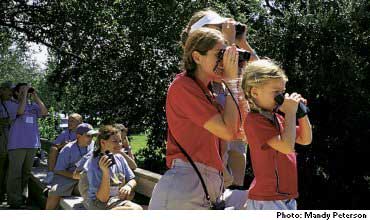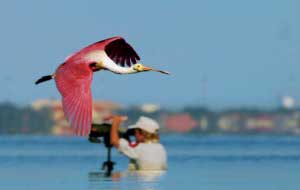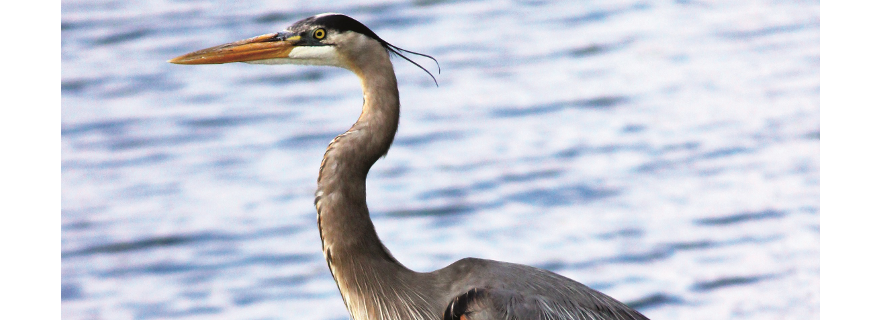By Mary Kelley Hoppe
In terms of sheer numbers – with more than 300 recorded bird species and 120 species of butterflies – the Tampa Bay region provides a dizzying opportunity to train your binoculars on winged creatures.
Luck y spectators will get a ringside seat at the 7th Annual Florida Birding & Nature Festival in St. Petersburg, October 7 through 10, 2004. This year’s lineup features more than 25 backbay adventures, field trips to some of the region’s top birding and wildlife areas, plus a dynamic array of speakers, children’s activities and dozens of seminars at Eckerd College.
y spectators will get a ringside seat at the 7th Annual Florida Birding & Nature Festival in St. Petersburg, October 7 through 10, 2004. This year’s lineup features more than 25 backbay adventures, field trips to some of the region’s top birding and wildlife areas, plus a dynamic array of speakers, children’s activities and dozens of seminars at Eckerd College.

Making keynote appearances at the 2004 Florida Birding & Nature Festival are (top to bottom) Dr. Carl Safina, author of “Eye of the Albatross” and “Song for the Blue Ocean,” master photographer Arthur Morris and birding luminary and butterfly enthusiast Kenn Kaufman.
The four-day festival begins Thursday, October 7, with a keynote talk by renowned ocean and sea bird conservationist, Dr. Carl Safina, president of the Blue Ocean Institute and author of the highly acclaimed books, “Eye of the Albatross” and “Song for the Blue Ocean.”
“Carl’s writing is poetry, you’ll be hooked from the first word,” says Ann Paul, interim manager of Audubon’s Florida Coastal Island Sanctuaries, who met Safina when he was heading up Audubon’s Living Oceans Program. His conservation efforts earned him a coveted $500,000 MacArthur Prize in 2000.
Other headliners include birding luminary and butterfly enthusiast Kenn Kaufman, and master photographer Arthur Morris, whose pre-dawn field photo expeditions to Ft. De Soto Park are always a sell-out.

Along with cooler temperatures, autumn brings the return of a spectacular procession of migratory birds, including peregrine falcons, red knots, marbled godwits, even long-billed curlews and whimbrels.
“One of my best birding experiences took place at Egmont Key on a festival field trip,” says Dr. Peter Stangel, southeast regional director of the National Fish and Wildlife Foundation. “Our plan was to bird the Australian pines and then head to the beach for shorebirds, but there were so many warblers in the pines that we just couldn’t leave. We spent the whole morning in an area about the size of a tennis court.
“We saw black-throated blue, blackburnian, prairie and worm-eating warblers and about 10 other species. It was so exciting that some of the people I was with were afraid I might hyperventilate.”
“That’s what I love about Florida,” says local photographer Aydelette Kelsey. “In every nook and cranny, nature flourishes.” Local residents and visitors will have a chance to explore barrier islands, beaches, seagrass meadows, mangrove forests and upland scrub communities accompanied by the experts and naturalists who know them best.
Location is everything. “We’re kind of on the line between the tropics and more northern zones,” says Paul. That, and an incredible diversity of habitat, makes the Tampa Bay region as attractive to tropic-loving birds like the roseate spoonbill and the rare reddish egret as it is to wild turkeys.
Field trips fill up fast, she adds, so it’s important to register early.
Part of the fun is probing the secret spaces smaller creatures frequent, places you might not know to look, says veteran trip leader Deb Chayett, a grant specialist with the Pinellas County Park Department. “When you help someone hone in on something as small as a single butterfly egg, the size of a pinpoint on the underside of a leaf, it’s incredibly exciting.”
But butterflies and birds aren’t the only focus. Wildlife lovers can also bone up on alligators, bats, and the lowly but laudable gopher tortoise in a series of talks on campus. A nature expo, butterfly tent and raptor exhibit also are planned.
Sharing the s tage that weekend is the 2004 Florida State Audubon Assembly at the Hilton St. Petersburg. Its roster features such notables as “puffin man” Steve Kress, whose pioneering techniques have been used around the globe to restore colonies of puffins, terns, storm-petrels, albatrosses and other seabirds. Transportation will be provided between the venues to accommodate those attending both events.
tage that weekend is the 2004 Florida State Audubon Assembly at the Hilton St. Petersburg. Its roster features such notables as “puffin man” Steve Kress, whose pioneering techniques have been used around the globe to restore colonies of puffins, terns, storm-petrels, albatrosses and other seabirds. Transportation will be provided between the venues to accommodate those attending both events.
Proceeds from the festival benefit the Pinellas County Environmental Fund, a program of the National Fish and Wildlife Foundation in partnership with Pinellas County. Funding supports Tampa Bay through matching grants that enable applied research, habitat restoration and environmental education.
“You feel privileged to see some of these creatures,” says Kelsey. “It can be a lesson in sitting still. I go to the Dunedin causeway many mornings to watch the regulars: laughing gulls and a tricolor heron, but one morning a flock of avocets lands and dozens of godwits appear. It’s a public place and full of secrets.”
[su_box title=”Florida Birding Festival” box_color=”#4aa396″ radius=”2″]WHEN: Thursday – Sunday October 7-10, 2004
WHERE: Eckerd College St. Petersburg, Fla.
FEATURING: Field trips On-campus seminars and workshops Butterfly tent and raptor exhibit Nature expo Just for Kids programs
With keynote guests: Dr. Carl Safina, Blue Ocean Institute
Kenn Kaufman Kenn Kaufman’s Nature Site
Arthur Morris Birds As Art
Article originally published Summer 2004.
[su_divider]
